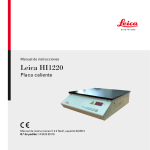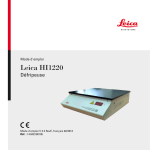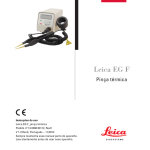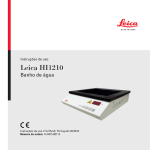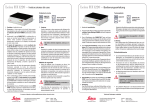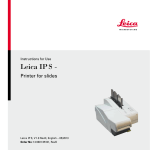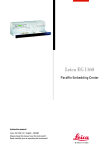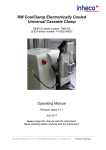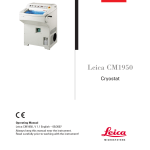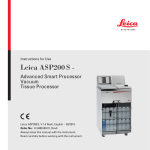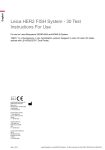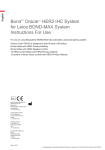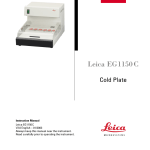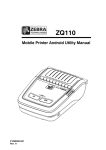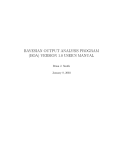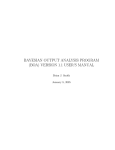Download Gebrauchsanweisung Leica CV 5030
Transcript
Instructions for Use Leica HI1220 Flattening Table Instructions for Use V 3.2 RevE, English 02/2013 Order No.: 14 0423 80101 NOTE The information, numerical data, notes and value judgments contained in this manual represent the current state of scientific knowledge and state-of-the-art technology as we understand it following thorough investigation in this field. We are under no obligation to update the present manual periodically and on an ongoing basis according to the latest technical developments, nor to provide our customers with additional copies, updates etc. of this manual. To the extent permitted in accordance with the national legal system as applicable in each individual case, we shall not be held liable for erroneous statements, drawings, technical illustrations etc. contained in this manual. In particular, no liability whatsoever is accepted for any financial loss or consequential damage caused by or related to compliance with statements or other information in this manual. Statements, drawings, illustrations and other information regarding the contents or technical details of the present Instructions for Use are not to be considered warranted characteristics of our products. These are determined only by the contract provisions agreed between ourselves and our customers. Leica reserves the right to change technical specifications as well as manufacturing processes without prior notice. Only in this way is it possible to continuously improve the technology and manufacturing techniques used in our products. This document is protected under copyright laws. All copyrights to this documentation are held by Leica Biosystems Nussloch GmbH. Any reproduction of text and illustrations (or of any parts thereof) by means of print, photocopy, microfiche, web cam or other methods—including any electronic systems and media—requires express prior permission in writing by Leica Biosystems Nussloch GmbH. For the instrument serial number and year of manufacture, please refer to the nameplate on the back of the instrument. © Leica Biosystems Nussloch GmbH Leica Biosystems Nussloch GmbH Heidelberger Str. 17 - 19 D-69226 Nussloch Germany Phone: +49 (0)6224 143-0 Fax: +49 (0)6224 143-268 Internet:http://www.LeicaBiosystems.com Leica HI1220 Flattening Table 3 Table of Contents 1. Important Information.....................................................................................................5 1.1 1.2 1.3 1.4 Symbols and their meanings....................................................................................................... 5 Qualification of personnel............................................................................................................ 6 Intended use of instrument.......................................................................................................... 6 Instrument type.............................................................................................................................. 6 2.Safety.................................................................................................................................7 2.1 Safety notes.................................................................................................................................... 7 2.2Warnings......................................................................................................................................... 8 3. 4. Instrument Components and Specifications..............................................................9 3.1 Technical data................................................................................................................................ 9 Instrument Setup............................................................................................................10 4.1 4.2 4.3 Installation site requirements.................................................................................................... 10 Unpacking and setting up the HI1220....................................................................................... 10 Setting up the power supply...................................................................................................... 11 5.Operation.........................................................................................................................12 5.1 5.2 5.3 5.4 6. 7. 4 Control panel fields on the instrument..................................................................................... 12 Switching the instrument on...................................................................................................... 12 Setting the temperature............................................................................................................. 13 Switching off the instrument..................................................................................................... 13 Cleaning and Maintenance.........................................................................................14 6.1 6.2 Cleaning the instrument............................................................................................................. 14 Replacing fuses............................................................................................................................ 14 Warranty and Service...................................................................................................15 Instructions for Use V 3.2 RevE – 02/2013 1. Important Information 1.1 Symbols and their meanings Warnings appear in a gray box and are marked by a warning triangle . Notes, i.e. important user information, appear in a gray box and are marked by an information symbol . (5) START Numbers and parentheses refer to item numbers in the illustrations. Function keys to be pressed on the instrument control panel are in boldprint capital letters. Manufacturer Observe the instructions for use! SN Serial number REF Order no. Instrument surfaces which become hot during operation are marked with this symbol. Avoid direct contact with these surfaces - they may cause burns. The CE labeling shows that the product corresponds to one or more applicable European directives. Environmental protection symbol of the China RoHS directive. The number in the symbol indicates the "Environment-friendly Use Period" of the product. The symbol is used if a substance restricted in China is used in excess of the maximum permitted limit. Symbol for labeling electrical and electronic equipment in accordance with Section 7 of the German Electrical and Electronic Equipment Act (ElektroG). ElektroG is the law regarding the sale, return and environmentally sound disposal of electrical and electronic equipment. The package contents are fragile and must be handled with care. Indicates the correct upright position of the package. Leica HI1220 Flattening Table 5 1. Important Information 1.2 Qualification of personnel • The Leica HI1220 may be operated by trained laboratory personnel only. • All laboratory personnel designated to operate this instrument must read these Instructions for Use carefully and must be familiar with all technical features of the instrument before attempting to operate it. 1.3 Instrument type All information provided in these Instructions for Use applies only to the instrument type indicated on the cover page. A nameplate indicating the instrument serial number is attached to the rear side of the instrument. Intended use of instrument The HI1220 microscope slide flattening table for paraffin sections is a heating plate with high heat output and precise temperature control. The HI1220 is suitable for flattening and drying cut tissue samples in all fields of biomedical research and routine diagnostics. Any other use of the instrument is considered improper. Failure to adhere to these instructions may result in an accident, personal injury, damage to the instrument or accessory equipment. Proper and intended use includes compliance with all inspection and maintenance instructions, along with the observance of all instructions in the Instructions for Use. 6 1.4 Fig. 1 Fig. 1 is provided as an example only and shows a valid nameplate for this instrument with the necessary information about instrument type and power requirement. The precise data for the various versions is specified in Chapter 3.1 "Technical data". Instructions for Use V 3.2 RevE – 02/2013 2. Safety 2.1 Safety notes • The safety and caution notes in this chapter must be observed at all times. • Be sure to read these notes even if you are already familiar with the operation and use of other Leica products. • The protective devices located on the instrument and the accessories must not be removed or modified. Only qualified service personnel authorized by Leica may repair the instrument and access its internal components. Residual risks • The instrument has been designed and constructed with the latest state-of-the-art technology and according to recognized standards and regulations with regard to safety technology. Operating or handling the instrument incorrectly can place the user or other personnel at risk of injury or can cause damage to the instrument or other property. The instrument may be used only as intended and only if all of its safety features are in proper working condition. Malfunctions which could impede safety must be remedied immediately. • Only original spare parts and permitted original accessories may be used. These Instructions for Use include important instructions and information related to the operating safety and maintenance of the instrument. The Instructions for Use are an important part of the product, and must be read carefully prior to startup and use and must always be kept near the instrument. These Instructions for Use must be appropriately supplemented as required by the existing regulations on accident prevention and environmental safety in the operator's country. Leica HI1220 Flattening Table This instrument has been built and tested in accordance with the safety requirements for electrical equipment for measurement, control, and laboratory use. To maintain this condition and ensure safe operation, the user must observe all notes and warnings contained in these Instructions for Use. The instrument's CE certificate can be found on the Internet at: http://www.LeicaBiosystems.com 7 2.Safety 2.1 Safety notes (continued) • In order to properly service the instrument, it is indispensable to read the User Manual before switching on the instrument and to familiarize yourself with all technical details. • Before connecting the instrument to the line voltage, ensure that the electrical power requirements of your laboratory match the values on the nameplate of the instrument. • When installing the power cable, always be sure to route it so that it cannot contact the heated surfaces of the instrument at any time. • The instrument is designed for indoor use only. • The instrument must be switched off and unplugged from the power supply during all repair and service work. • During operation, the instrument surface can be very hot. Risk of injury! Do not store any combustible and flammable substances near the instrument. 2.2Warnings The safety devices installed in this instrument by the manufacturer only constitute the basis for accident prevention. Operating the instrument safely is, above all, the responsibility of the owner, as well as the designated personnel who operate, service or repair the instrument. To ensure trouble-free operation of the instrument, make sure to comply with the following instructions and warnings. Please note that electrostatic charge may result through direct or indirect contact with the Leica HI1220. 8 Instructions for Use V 3.2 RevE – 02/2013 3. Instrument Components and Specifications 3.1 Technical data Nominal supply voltages: Two factory-preset voltages (not user-adjustable): 100-120 VAC + 10 % 230-240 VAC + 10 % Nominal frequency: 50/60 Hz Nominal power: 350 VA Main fuse: 2 melting fuses, 5x20 mm, UL-approved For 100-120 V: 5x20 mm, 2x T 5A L250 VAC For 230-240 V: 5x20 mm, 2x T 2.5A L250 VAC Dimensions: 350x310x100 mm Empty weight: 3.6 kg (w/o packaging) Relative humidity: 20-80 %, non-condensing IEC 1010 classification: Protection class: 1 Pollution degree: 2 Overvoltage category: II Operating temperature range: +15 °C to +40 °C Temperature control range: Room temperature to 75 °C Operating elevation: maximum of 2000 m above sea level IP protection class (IEC 60529): IP20 Leica HI1220 Flattening Table 9 4. Instrument Setup 4.1 Installation site requirements • When installing the power cable, always be sure to route it so that it cannot contact the heated surfaces of the instrument at any time. • The power socket to which the instrument is to be connected to has to be located near the instrument and easily accessible. • The power supply must be at a distance no greater than the length of the power cable – an extension cable must NOT be used. • The substrate must be largely vibration-free and have sufficient load capacity and rigidity for the weight of the instrument. • Avoid impacts, bright direct light, and excessive temperature fluctuations. • The instrument must be connected to a suitable power socket. Use only the provided power cable, which is intended for the local power supply. 4.2 Unpacking and setting up the HI1220 Set the carton on a flat surface, cut through the adhesive tape (Fig. 2) and open the carton (Fig. 3). Fig. 2 Fig. 3 10 Instructions for Use V 3.2 RevE – 02/2013 4. Instrument Setup 4.2 Unpacking and setting up the HI1220 (continued) Remove the accessories and carefully lift the instrument out of the carton (Fig. 4). Hold the instrument firmly with one hand, pull off both foam sections (Fig. 5) and remove the dust cover. 1 õ õ 2 Fig. 4 4.3 Fig. 5 Setting up the power supply • Before connecting the power cable, make sure that the power switch (3) on the rear of the instrument (Fig. 6) is switched to "0" = OFF. • Use the instrument with the provided power cable only. • Insert the connector of the power cable (Fig. 5, 2) into the connection socket (4) and plug the power plug into the power socket Leica HI1220 Flattening Table 3 4 Fig. 6 11 5.Operation 5.1 Control panel fields on the instrument 5= POWER LED Is illuminated when the instrument is switched on with the main power switch. 6= SET Indicates the selected target temperature. 7 = Set key: lower temperature. 8 = Set key: increase temperature. 9= RUN/STOP Switch instrument on or off. 10= Display 5.2 10 5 6 7 8 9 Fig. 7 Switching the instrument on • Switch on the instrument with the power switch on the left rear panel of the instrument (Fig. 6, 3). • The green LED display POWER on the front panel is then illuminated. 12 Instructions for Use V 3.2 RevE – 02/2013 5. Operation 5.3 Setting the temperature • Pressing the RUN/STOP button on the front panel brings the temperature of the instrument to the latest stored target value. The displayed temperature corresponds to the current actual value. • The set target temperature is shown in the display (Fig. 7, 10). • To adjust to the desired temperature, hold down the corresponding set key (Fig. 7, 7+8). The display changes slowly for the first 8 digital steps, then more quickly after that. The temperature display refers to the target value. After the desired temperature is reached, release the set key. The displayed value is saved automatically. This stored target value will continue to be displayed for about 2 seconds, then the current actual temperature display will appear again. • The target temperature can be checked by pressing the SET key (Fig. 7, 6). After changing the target temperature, the temperature may temporarily rise once a little. Therefore extremely temperature-sensitive samples should not be positioned until after reaching the set temperature (observe the temperature display!). The target value remains saved both when the instrument is switched off (RUN/STOP key or power switch) and in case of power failure and disconnection from the power supply. 5.4 Switching off the instrument • The instrument can be switched off by pressing the RUN/STOP key. You do not have to switch the main power switch on or off each time for everyday routine use. Leica HI1220 Flattening Table 13 6. Cleaning and Maintenance 6.1 Cleaning the instrument • Before cleaning the instrument, turn off using the power switch (Fig. 6, 3) and disconnect from the power supply. • The instrument has a continuous front panel and no lateral cooling slots, so the surfaces are smooth and easy to clean. • All surface materials are resistant to common laboratory detergents. The instrument must be switched off and have cooled down for cleaning. Do not use organic solvents (e.g. alcohol or xylene)! 6.2 Replacing fuses Switch the unit off and unplug it. Use only the supplied replacement fuses. Both fuses must have the same rating (check the imprint!). Fuses must always be switched out in pairs. • Insert a small screwdriver into the cutout (Fig. 8, 11) and carefully pry out the fuse insert (12). • Remove the fuse holder and replace the defective fuses with two new ones (13). • Then reinsert the fuse holder and press it into place. 11 õ 13 12 Fig. 8 14 Instructions for Use V 3.2 RevE – 02/2013 7. Warranty and Service Warranty Leica Biosystems Nussloch GmbH guarantees that the contractual product delivered has been subjected to a comprehensive quality control procedure based on the Leica in-house testing standards, and that the product is faultless and complies with all technical specifications and/ or characteristics warranted. The scope of the warranty is based on the content of the concluded agreement. The warranty terms of your Leica sales organization or the organization from which you have purchased the contractual product shall apply exclusively. Service information If you require technical service or replacement parts, please contact your Leica sales office or dealer who sold the product. The following inputs are required: • Model name and serial number of the instrument. • Location of the instrument and name of a contact person. • Reason for the service call. • Date of delivery. Decommissioning and disposal The instrument or parts of the instrument must be disposed of according to existing applicable, local regulations. Special attention should be paid to the lithium cell of the electronic circuit board! Leica HI1220 Flattening Table 15 Notes 16 Instructions for Use V 3.2 RevE – 02/2013 www.LeicaBiosystems.com Leica Biosystems Nussloch GmbH Heidelberger Straße 17-19 D- 69226 Nussloch Phone: +49 6224 - 143 0 Fax: +49 6224 - 143 268 Web: www.LeicaBiosystems.com


















